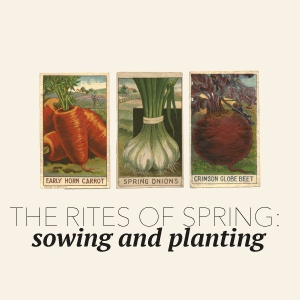All over the world spring is associated with that time of year when garden seeds are sown.
In many parts of South Africa however, we are blessed with milder winters and warmer autumns. It is therefore possible to have two spring seasons, but unfortunately only as far as gardening goes. Perennials and bi-annuals can be planted in autumn to flower the following summer (in cooler climates this process takes two full summer seasons). By managing drought and frost, seedlings can be sown in seedbeds and boxes in autumn and planted out just before winter.


Preparing the soil
A seedling’s success depends on a good soil mixture, good drainage and adequately textured material to support good root development. A great seedling soil mix can be prepared by mixing together one part well-rotted compost, one part topsoil and one part washed river sand.
The compost should consist of naturally decomposed vegetable matter such as old leaves, lawn clippings and other green gardening waste. This can be rubbed through a seven millimetre (mesh) sieve to ensure that larger particles are broken down. Make sure there is no manure or wood ash in the compost, as this could burn the young plants. The topsoil should also be sieved through the seven millimetre sieve. The washed river sand should preferably be coarser in texture, with larger particle sizes, but also passed through the seven millimetre sieve.
Seed boxes and seedbeds
In effect seed boxes are nothing more than miniature seedbeds. Seedbeds are made up on the ground, but are usually raised above ground level to keep them safe from flooding. Seedbeds can be of a temporary or permanent nature.
If you have an area in your garden that has good light, affords protection from the cold in winter, yet remains cool in the heat of summer, it would be an ideal location for a more permanent seedbed.
The bed could be constructed from good, solid timber, or built up with brick and mortar. It is, however, extremely important to ensure good natural drainage. The soil below the bed should be given a proper digging. If your soils are rich in clay or otherwise prone to waterlogging, it is imperative that you install a French drain (rock drain) and a lateral to channel away excessive water.
A French drain can be made by excavating a trench to a depth of about 500 millimetres below the natural soil level. Allow for a slight fall, so that there is a lower point from which your drainage lateral (or pipe) can be laid to channel excess water to any naturally better draining area in your garden, or to a sump from where it could be pumped out if necessary.
The first 400 millimetres could be filled up with coarse builders’ rubble or 23 millimetre stone chips. This is then covered with bidum, a semi-permeable geotextile that ensures soil does not wash into the underlying stone layer along with the water. The last 100 millimetres and the first 100 millimetres of the raised bed could be filled with a coarser, well-draining soil mix. Finally, the rest of the bed is filled with the seedling soil mix described above.
However, if you do not want to go through the hassles of establishing a permanent seedbed, excellent plastic seed trays are commercially available. These are also filled with the seedling soil mix. When placing your trays in their desired position, make sure they are level. You do not want any gradient, as this would later lead to pooling at the lower end when watering. After filling the seedbed/trays with the growing medium, use a flat board or brick to press down firmly upon the soil surface, leaving about 2 centimetres between the upper edge and the final soil level.
It is now necessary to water the seedbed thoroughly. Allow the seedbeds/trays to drain overnight before sowing your seed the following morning.
Sowing the seeds
Fine seed is usually broadcast or evenly sprinkled across the surface of the seedbed or tray. The easiest way to do this is to cut off the corner of the seed packet with a pair of scissors – this will allow the seeds to run smoothly. If the corner is torn off, it causes the seeds to get stuck on the frayed edges. After cutting, gently tap the side of the packet with your finger. If the seed is too fine, it could be bulked with a few teaspoons of washed river sand. Spoon the sand into the packet and shake it to ensure even distribution of the seed within the sand. Working gently, broadcast evenly across the seedbed surface.
Vegetable seeds are sometimes placed in rows or drills. This is done by lightly pushing a dowel or the edge of a plank into the surface of the bed. This results in a slight depression (or drill) and can be repeated throughout the bed to form evenly spaced rows. The seed is then evenly distributed along these drills. Care must always be taken to avoid clumping or bunching the seeds, as this will create competition, which would impact negatively on the health and vigour of your seedlings. Larger seeds could be planted individually by hand at the required spacing.
After sowing, the seed should be covered by gently sieving a light covering of dry soil mix over it – care must however be taken not to smother the seeds. A good rule of thumb is to cover the seeds with the same amount of soil mix as the thickest part of the seed. Once covered, use a board to lightly press the seeds into the soil. This will ensure good bedding. Finish by sieving a little more of the dry soil mix as a final covering.
![]()
Treatment after sowing
As the seedbeds or trays would have been given a thorough drenching the previous day during bed preparation, the seeds will not require watering immediately after planting. Capillary action in the soil will draw sufficient moisture to the surface.
Most seedlings need to be shaded. Shading could be achieved with the appropriate grade of shade cloth available from your local supplier. Care must be taken to check on seedlings every morning and evening. Soils should never be allowed to dry out.
When watering, it is advisable to use a watering can with a watering rose, as this will result in an even flow over the soil surface. Watering should be done in a single, fluid movement, starting from the one end the seedbed, and then passing over the bed, to the other. This allows for an even flow without causing dripping or splashing, as this could dislodge fine seed. You definitely do not want to use a hosepipe, as this will displace the soil surface and wash the seed into clumps, resulting in irregular germination. If you have one, a horticultural sprayer would be an even better alternative to the watering can, as the fine mist will not disrupt the seedbed.
One of the biggest problems in raising seedlings is “damping-off”. Excessive moisture attracts a fungus which causes the seedlings to rot at soil level. This fungus thrives in damp, airless conditions. If your seedlings start showing symptoms of “damping-off”, it is a clear indication of over-watering. Remove all the affected plants and supporting soil. You can then lightly dust the remaining plants with sulphur, as this is a good fungicide. It is a good practice to air the plants by removing the covers periodically, as fungi dislike aerobic conditions. Remember, it is better to slightly under-water rather than over-water: slightly under-watered plants tend to be healthier and more drought-tolerant. Slugs and snails are a menace to seedlings, and should be taken care of with snail bait.
![]()
Pricking out of seedlings
Most seedlings are pricked out at the four-leaf stage; however some can be pricked out in the two- and three-leaf stages. The four-leaf stage is a good benchmark if other stages are not specified in your sowing guide. Please note that the leaf stage refers to true leaves, and not the cotyledons emerging from the seed.
Give the seedlings a good watering just prior to pricking out. Seedlings can be pricked out into nursery beds, punnets, pots, or even bags: in some cases, even directly into their permanent positions. The soil medium should be the same as that for the seedbeds, if however slightly coarser. This can be achieved by sieving through a nine to eleven millimetre sieve. Nursery beds or containers should be adequately prepared in advance. They should be given a proper soaking twenty four hours before pricking out.
Seedlings can be pricked out with the aid of a sharp, pointed stick or dibber, or even an old, dull knife blade. The seedlings are gently loosened from the medium and lifted by one of the leaves – do not lift the plant by the stem as you could crush it, resulting in permanent damage to the seedling. Make a hole in the soil with the dibber and place the seedling in it, ensuring the roots are gently pushed to the bottom with the point of the dibber. Care must be taken not to damage the roots. Then gently pinch the soil, closing the hole, and firming the plant. When pricking out into nursery beds, space the young plants correctly to avoid crowding. Unless otherwise stipulated in your sowing guide, between four and eight centimetres generally provides for good spacing.
Seedlings that have been sown in drills in the open ground and in their permanent positions will have to be thinned. Remove plants that are too close together, and fill in any possible gaps, thus ensuring even and proper final spacing. Water again, carefully, so as not to flood the beds or cause the seedlings to wash out.
Do not over-water!
Remember, the seedlings are still small plants, and until such time as they are stronger and healthier, they will continue to require shading and protection from the elements.
Planting out into permanent positions
Apart from seeds planted in drills, all the seedlings from the seedbed or in nursery pots, trays, or bags would of course also need to be planted out into permanent positions in the garden.
Seedlings in pots, individually pocketed seed trays, or bags are easy enough to handle. They can be left in these containers until they are healthy and have a well-developed root mass before being planted into their final positions. If the plants have always had protection from the elements, it is good practice to move them to a less protected area a week or two before planting out – this process is termed “hardening-off”. This ensures that they are not overwhelmed by the new conditions they may be subjected to in their final locations.
Seedlings in nursery beds and non-compartmentalised seed trays should be planted out before the root masses of neighbouring plants start getting tangled, as this will definitely result in massive root damage when lifting out the plants. Such root damage will most definitely set these plants back. If at all possible, these plants should also be hardened-off first.
Happy gardening!
Basic tools and equipment
For those new to sowing, these are a few tools that will make life a lot easier:
- spade
- wheelbarrow
- rake
- hard broom
- seed trays
- pots
- potting bags
- shade cloth
- watering can
- builder’s wooden float
- dibber
- hand trowel
Credit – Plaastoe.co.za

